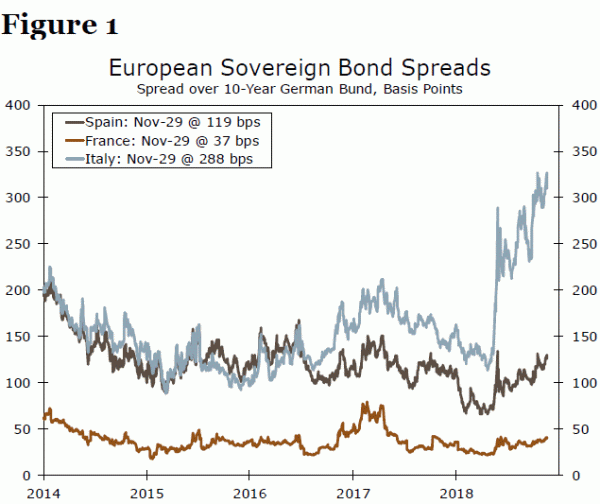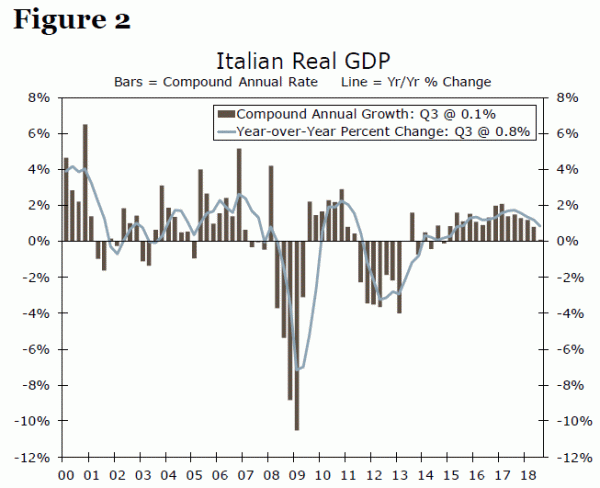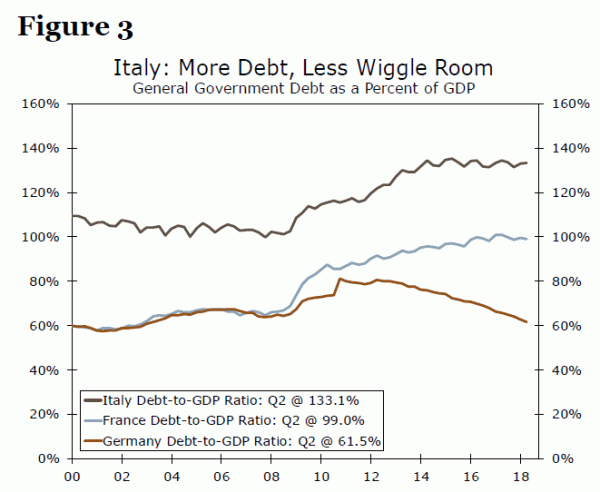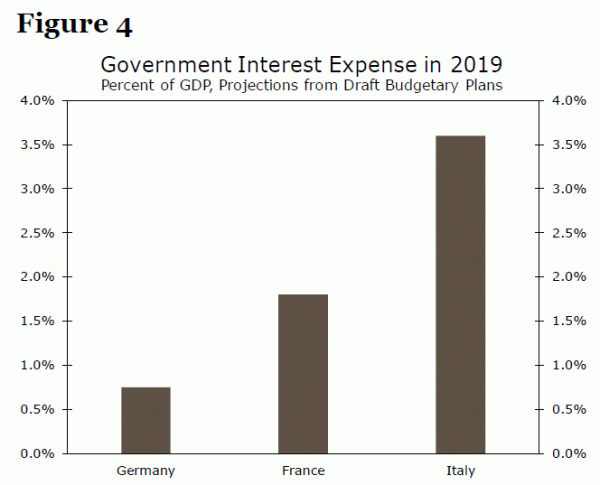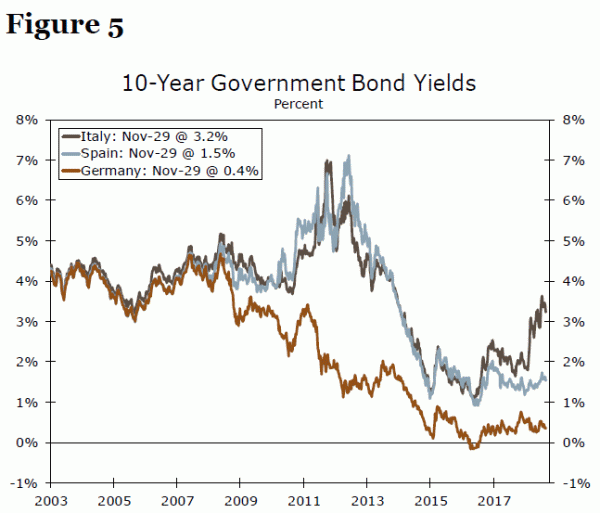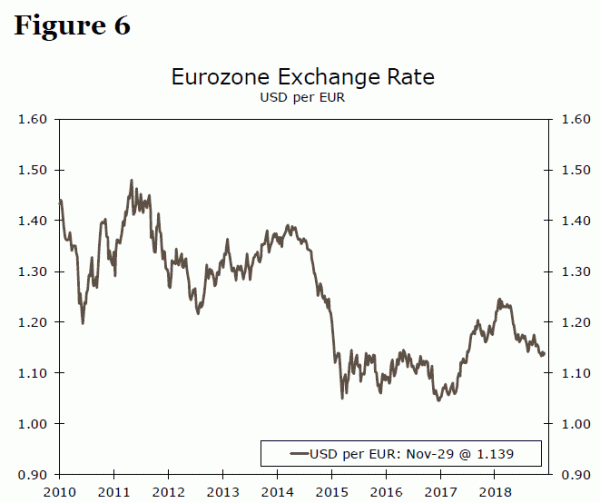Executive Summary
Since our most recent special report on Italy, Italian policymakers have continued full steam ahead with their plans to ease fiscal policy next year through a combination of tax cuts and increased spending. Over the past eight weeks, there have been multiple back and forth exchanges between Italian and EU policymakers on the structure and budget impact of these policies. Italy has gradually made some modest concessions, but through each iteration Italy has stuck to its initial deficit target of 2.4% in 2019. Thus far, EU officials have remained unsatisfied. In a report issued on November 21, the European Commission took another step toward an excessive deficit procedure (EDP) against Italy. In short, the report showed that EU officials remain concerned about the fiscal outlook in Italy, and that they are exhibiting a willingness, at least for now, to use all of the tools at their disposal to enforce fiscal discipline.
So what happens next? It is possible that the European Commission could formally launch the EDP against Italy next week, though sometime in the second half of January/first half of February appears more likely. What would an EDP entail? After the process officially begins, Italy would have either three or six months to correct its fiscal excesses, with the three-month window reserved for particularly serious violations. Assuming Italy were to get the six-month window, this timeline implies the process could come to a head sometime in mid-2019. Were Italy to continue to defy Brussels after this time has elapsed, the country could be subject to a penalty of 0.2% of its GDP (about €3.5 billion), with growing penalties over time possible in the face of continued defiance by Rome. In this report, we update our readers on developments in Italy, lay out next steps and provide three potential scenarios for how things play out. In our view, the most likely outcome is that an eventual compromise will be reached before financial penalties are imposed on Italy, though it could take several months before a resolution is realized.
Italy’s Budget Remains in Focus
Since our most recent special report on Italy, Italian policymakers have continued full steam ahead with their plans to ease fiscal policy next year through a combination of tax cuts and increased spending. Over the past eight weeks, there have been multiple back and forth exchanges between Italian and EU policymakers on the structure and budget impact of these policies. Italian bond yield spreads have remained elevated over that period (Figure 1), while real GDP growth in Q3 was disappointingly slow (Figure 2). Italy has gradually made some modest concessions, such as a backup plan that involves a public asset sale should next year’s target not be met. Through each iteration, however, Italy has stuck to its initial deficit target of 2.4% in 2019, well above the 0.8% target for 2019 proposed by the previous government back in April.
Thus far, EU officials have remained unsatisfied. In a report issued on November 21, the European Commission took another step toward an EDP against Italy. In short, the report showed that EU officials remain concerned about the fiscal outlook in Italy, and that they are exhibiting a willingness, at least for now, to use all the tools at their disposal to enforce fiscal discipline. Why this tough approach for Italy in particular? For example, a deficit of 2.4% of GDP next year in Italy would still be smaller than some other countries. France, for instance, is targeting a deficit of 2.8%.
The reasons are multi-faceted and nuanced, but Italy faces three fundamental fiscal headwinds. First, Italy has the second-largest debt-to-GDP ratio in the EU, behind only Greece. At 133% of GDP, Italy’s sovereign debt load is much larger than France’s or Germany’s (Figure 3). This previously accumulated debt gives Italy less leeway for additional deficit-financed stimulus if Italian authorities are to bring the debt-to-GDP ratio down over time. Second, Italy spends a much larger share on interest expense. At 3.6% of GDP, Italy’s interest expense is double France’s and quadruple Germany’s (Figure 4). Finally, the projected directional trend in Italy’s finances is set to move in the wrong direction under the proposed budget. In Italy’s draft budgetary plan, the structural budget deficit is projected to go from 0.9% of potential GDP in 2018 to 1.7% of potential GDP in 2019. By contrast, France projects a structural budget deficit of 2.0% of GDP, but this number is on an improving trend compared to previous years. In short, the EU appears wary of allowing a major economy with a large debt level and interest expense to reverse direction on its deficit target, even if that target remains within the 3% rule.
So what happens next? Next, EU government representatives on the European Council have to sign off on the European Commission’s report recommending an EDP, which appears likely very soon. From there, it is possible that the European Commission could formally launch the EDP against Italy as early as next week, though sometime in the second half of January/first half of February appears more likely. What would an EDP entail? After the process officially begins, Italy would have either three or six months to correct its fiscal excesses, with the three-month window reserved for particularly serious violations. Assuming Italy were to get the six-month window, this timeline implies the process could come to a head sometime in mid-2019. Were Italy to continue to defy Brussels after this time has elapsed, the country could be subject to a penalty of 0.2% of its GDP (about €3.5 billion), with growing penalties possible over time in the face of continued defiance by Rome. We lay out below three scenarios that portray how the ongoing Italian-EU budget relations could play out in the coming months.
Scenario One: Dragging Their Feet to an Eventual Compromise
In scenario one, the process continues to drag on as it has for the past few months. Officials in Brussels continue to slowly turn up the heat on Rome, while Italian policymakers remain defiant. Behind the scenes, however, the dialogue between the two sides continues. Eventually, perhaps even as late as after the EU Parliamentary elections in May 2019, the two sides reach an acceptable compromise. Both sides have incentives to avoid the worst-case-scenario. On Italy’s side, financial markets can keep the pressure on Italian policymakers. An increase in sovereign bond yields would pressure the government’s interest expense, while also raising benchmark borrowing rates throughout the Italian economy. Falling bond prices would pressure Italian banks and retail investors and likely dent the Italian stock market, unwelcome developments for the government coalition in power. From the EU side, one has to wonder just how far policymakers are willing to directly intervene in Italy’s sovereign budget. Unlike Greece in years past, Italy is not in any need of direct support at this point in time, and perhaps more fundamentally, Italy is much larger. Italy is one of the world’s ten largest economies with a sovereign debt market of about €2 trillion.
The EU report from Nov. 21 discussed earlier seemed to take particular issue with measures to lower the retirement age, as this could reduce the supply of labor and hamper potential economic growth. Proposals to increase public investment, in contrast, appeared to be given more leeway, at least in our reading of the report. Perhaps a potential compromise exists whereby some transfer payment stimulus is scrapped, but other investment-inducing policies (via the tax code and/or direct public investment) are allowed to remain more or less intact. Over the past week or so, Italian leaders have hinted they might adjust the 2.4% target for 2019, perhaps signaling some additional flexibility is in the offing. While the situation clearly remains very fluid and more back and forth is likely, this a tentative first sign that a compromise might be reached over time.
Under this scenario, Italian bond yields would likely wax and wane roughly within their recent range over German bond yields. Once a compromised is reached, spreads would likely compress, though probably not fully retracing back to the levels seen before the election. The euro would probably muddle through relatively close to current levels until a compromise was reached, at which point it would likely start to move higher versus the dollar.
Scenario Two: Unable to Meet Its Promises, Italy’s Government Collapses
Although Italian policymakers have not done enough to appease the budget hawks in Brussels, it is becoming clearer that the soaring rhetoric and outsized fiscal promises made on the campaign trail in Italy are unlikely to become a reality in full. Even if Italy’s draft budget plan were accepted as is, allocating the finite stimulus across so many competing priorities (tax cuts, increased public investment, a lower retirement age, a “citizens income,” etc.) would be a challenging political task. This task will be doubly difficult given the somewhat unusual coalition government composed of the leftist Five Star Movement and the right-wing Lega. Since the coalition was formed in May, there have been at times signs of disagreement between the two major ruling parties over how to prioritize the cornucopia of fiscal easing measures.
If something were to happen that makes the deficit target even harder to reach (slower-than-expected growth, another jump in interest rates, an especially hard line from the European Commission, etc.), it is easy to imagine the coalition government collapsing under the strain of too many promises and not enough fiscal wiggle room. Collapsing governments are nothing new in Italy; the current government is the 66th the country has had since World War II. Were this to occur, a caretaker government would likely need to take charge, reducing the probability of legislation sponsoring significant fiscal stimulus in our view. Under this scenario, a relief rally would likely cause Italian bond yields to fall, all else equal, with spreads over German bunds moving closer to their pre-election levels. The euro would probably rise versus the dollar, although any euro gains could be limited by uncertainty around the next steps for Italy’s government.
Scenario Three: No One Blinks, and Financial Penalties Eventually Occur
Under this third scenario, the process continues to drag on, but with little progress toward a compromise agreement. This scenario potentially unfolds as follows. Italian policymakers stand their ground, arguing that they were elected with a mandate to enact the policies they support. Though rising financing costs are a concern, for now interest rates have not risen so much that they surpass the levels of 5-10 years ago (Figure 5). The weighted average maturity of Italian sovereign debt outstanding is about seven years, with a weighted average coupon of roughly 3.1%. As a result, some of the debt maturing today is still being refinanced at lower rates. As a final point, Italian policymakers may be emboldened by the fact that the European Commission has never actually utilized the EDP to impose financial sanctions on a country. On the EU side, with government debt still elevated across Europe and memories of the sovereign debt crisis still fresh, policymakers in Brussels stand their ground, hoping to prevent other countries from following Italy’s lead.
Were financial sanctions to appear imminent, the prospects of a potential Italian exit from the Eurozone would probably come more sharply into focus. This would be a significant economic and financial market development, and in our view Italian bond yields would likely surge, the euro would come under pressure and volatility would increase across financial markets throughout the world. The upshot, however, is that skyrocketing financing costs and a plummeting Italian stock market could potentially move Italian decision makers closer to either of the first two scenarios, namely a compromise or a government collapse. In either of those scenarios, we would expect the euro to stage a recovery versus the dollar following its initial depreciation.
Conclusion
In our view, the scenarios above are listed in the order of most likely to least likely. More specifically, we think an eventual compromise will occur before financial penalties are imposed on Italy, though it may take several months before that compromise is reached. It also strikes us as quite possible that the Italian government could collapse, given the history of instability in Italy and the strain of maintaining a coalition government with a finite degree of fiscal stimulus to parcel out. Financial penalties are a possibility; however, they would probably not take place for quite some time, and their imminent enactment could somewhat paradoxically bring about a resolution.
More thematically, we reiterate our longer-run view laid out in our previous report on the Italian budget. The challenges of stagnant living standards and high debt levels that have sparked the current political situation are unlikely to abate anytime soon. Even if Italian policymakers thread the needle on fulfilling their campaign promises while avoiding sanctions from Brussels, rising rates in Europe in the years ahead will likely put additional pressure on the sustainability of Italian debt, making future policy choices even more daunting. Furthermore, unless real GDP per capita rises in a meaningful and sustained way, the populist rumblings in the Italian political system are unlikely to completely fade away. Thus, we believe Italian budget drama is likely to periodically come into focus for financial markets for years to come.




